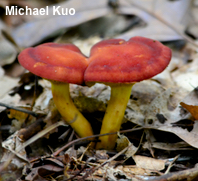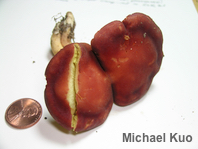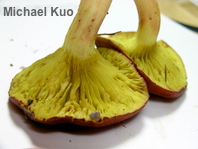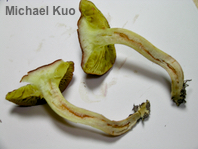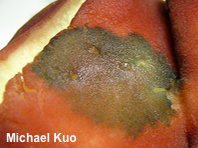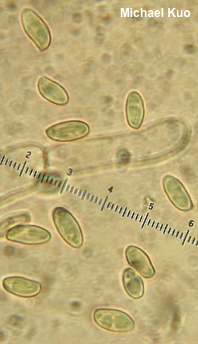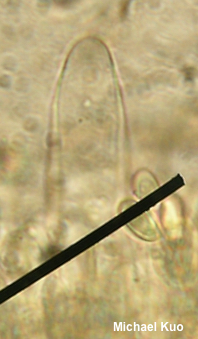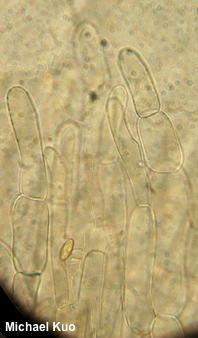| Major Groups > Gilled Mushrooms > Phylloporus & Phylloporus > Phylloporus 01 |

|
Phylloporus 01 [ Basidiomycota > Boletales > Boletaceae > Phylloporus . . . ] by Michael Kuo, 24 October 2025 Maybe this is just an orange version of Phylloporus rhodoxanthus, but I'm holding it up as potentiallly different, just in case. Like Phylloporus rhodoxanthus, the orange collections illustrated and described here are oak-associated gilled boletes with yellow basal mycelium and a green reaction to ammonia. But they are, well, orange—and there is also a difference in the pileipellis: the orange-capped mushroom features short-septate elements in the pileipellis (elements 2–3 times as long as wide), along with subterminal cells that are often wider than the terminal cells. Beans, you say. That don't amount to a hill o' beans, in the parlance of the collection's geographical location. Fine. But there is an orange, oak-associated species from Costa Rica, Phylloporus aurantiacus, which differs in its smaller proportions, negative ammonia reaction, and its significantly smaller and less spindle-shaped spores, so maybe orange is the new gilled bolete. Orange you glad I didn't say banana? Description: Ecology: Presumably mycorrhizal; collected under northern red oak, persimmon, and flowering dogwood; growing gregariously; summer; distribution unknown. The described and illustrated collection is from Illinois. Cap: 4–9 cm; convex, becoming broadly convex; moist; bald; bright reddish orange when fresh, darkening to reddish brown. Gills: Running down the stem; close; short-gills frequent; yellow, developing a few reddish spots. Stem: 5–6 cm long; up to about 1 cm thick; tapered downward; yellowish, with reddish fibrils; basal mycelium yellow. Flesh: Pale yellow; not staining when sliced. Odor and Taste: Not distinctive. Chemical Reactions: Ammonia green on fresh cap surface; red on dried cap surface. Microscopic Features: Spores 8–10 x 4–5 µm; fusiform; yellowish in KOH. Pleurocystidia to 75 x 12 µm; widely cylindric to subfusiform; smooth; walls 0.5–1.5 µm thick; hyaline in KOH. Pileipellis a trichoderm; elements 8–14 µm wide, smooth; hyaline to yellow in KOH; terminal cells often short-cylindric (length = 2–3 x width) with rounded apices; subterminal cells usually wider than terminal cells, often short-cylindric. Stipitipellis a layer of repent, parallel, cylindric hyphae 5–15 µm wide, smooth, hyaline in KOH, with caulohymenium in bundles; caulocystidia 45–60 x 12–15 µm, clavate, smooth or roughened, hyaline in KOH. Clamp connections not found. REFERENCES: (Neves & Halling, 2010; Gutiérrez-Domínguez et al., 2024.) Herb. Kuo 07131401. This site contains no information about the edibility or toxicity of mushrooms. |
© MushroomExpert.Com |
|
Cite this page as: Kuo, M. (2025, October). Phylloporus 01. Retrieved from the MushroomExpert.Com Web site: http://www.mushroomexpert.com/phylloporus_01.html |
